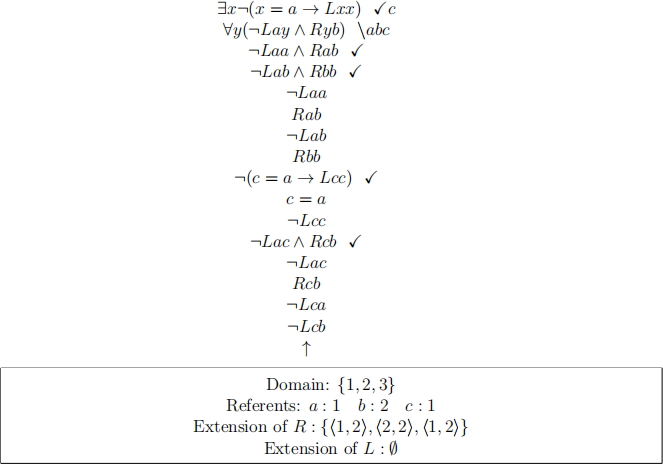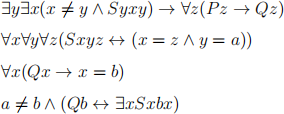PHIL1012 Introductory Logic · Final Assignment · Stuvac
Hello, dear friend, you can consult us at any time if you have any questions, add WeChat: daixieit
PHIL1012 Introductory Logic · Final Assignment · Stuvac
1. Let α be a proposition of GPLI whose main operator is a universal quantifier, and consider the argument form

(i) Are there any valid arguments of this form? If so, give an example. If not, explain why not.
(ii) Are there any sound arguments of this form? If so, give an example. If not, explain why not.
2. Consider the following saturated open path and model.

(i) Explain why the model has not been read off the open path correctly.
(ii) Are all of the propositions on the open path true on the given model? Explain your answer.
(iii) Read off a correct model from the open path.
3. Translate the following into GPLI:
Dogs don’t bark at themselves unless they are very confused.
4. Translate the following into GPLI:
Alfred stole at least three things from Mary, but Mary is unperturbed.
5. Translate the following into GPLI:
Ruth is the only logician who both studied with Alfred and is smarter than him.
6. Here is a model:

(So for every number 1, 2, 3, ... in the domain, the extension of D contains an ordered pair with that number in first position and the number twice its size in second position.)
State whether the following propositions are true or false on the model, and briefly explain your answers.

7. Give an example of a model that has exactly two objects in its domain and on which all of the following four propositions are true.

8. Use a tree to test whether the following proposition is a logical truth. (Present the tree, and say whether the proposition is a logical truth or not.) If the proposition is not a logical truth, read off a model from your tree in which the proposition is false (and indicate the path from which you are reading it off).

9. Use a tree to test whether the following argument is valid. (Present the tree, and say whether the argument is valid or invalid.) If the argument is invalid, read off a counterexample from your tree (and indicate the path from which you are reading it off).

10. Consider the following two propositions.

(i) What is the maximum number of objects a model can have in its domain if both of the propositions are true on that model? Explain your answer.
(ii) Give an example of a model that has the maximum number of objects in its domain and on which both of the propositions are true.
11. Say that an argument is super invalid if every model (that assigns referents/extensions to all names/predicates that appear in the argument) is a counterexample to it.
(i) Without using any connectives other than negation, give an example of a super invalid argument with a single premise.
(ii) Is there a proposition β such that (a) β doesn’t contain any quantifiers or the identity predicate (but β may contain any of the connectives) and (b) the argument you gave in part (i) becomes valid when β is added as a premise to it? If so, give an example of such a β. If not, explain why no such β exists.
12.
(i) Give an example of a proposition in GPLI that is false on every model whatsoever that has fewer than four objects in its domain.
(ii) Say that a wff α is shorter than a wff β if the number of symbols in α is less than the number of symbols in β. For example, Rab is shorter than ∀xQx.
For each of the predicate logics we’ve studied (MPL, GPL, GPLI), give an example of a logical truth that is as short as possible in that logic. In other words, give an example of a logical truth in MPL such that there are no logical truths of MPL shorter than it; give an example of a logical truth in GPL such that there are no logical truths of GPL shorter than it; and give an example of a logical truth in GPLI such that there are no logical truths of GPLI shorter than it.
2023-11-10